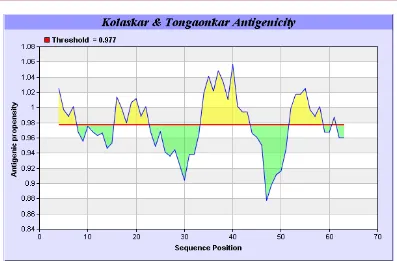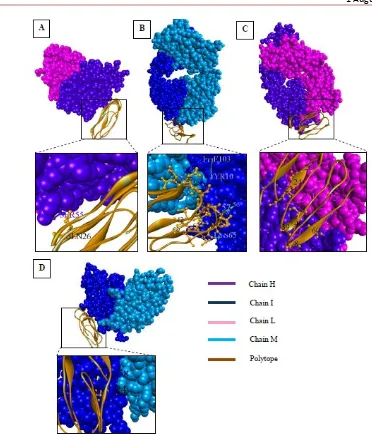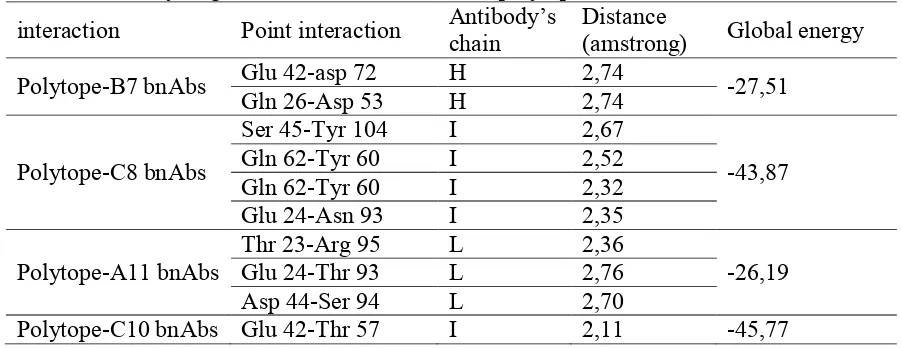Polytope Prediction for Dengue Vaccine Candidate Based on
Conserved Envelope Glycoprotein of Four Serotypes of Dengue
Virus and Its Antigenicity
Karimatul Himmah1, Fitriyah1,2, Tri Ardyati1, Custer Deocaris3, Widodo1*
1
Biology Department, Faculty of Mathematics and Natural Sciences, University of Brawijaya, Malang, East Java, Indonesia
2
Biology Department, Faculty of Science and Engineering, State Islamic University of Maulana Malik Ibrahim, Malang, Indonesia
3
Technological Institute of the Philippines
Corresponding author: [email protected]
Received 24 June 2016, Revised 1 August 2016, Accepted 1 August 2016
ABSTRACT
Dengue fever reported endemic in tropical and sub-tropical country. Dengue fever caused by dengue virus, has Envelope protein that often used for vaccine development to prevent the virus infection. Vaccine development to prevent four serotype dengue virus infection still unavailable. This study aims to design polytope from four conserved epitopes of dengue virus envelope glycoprotein to prevent infection of heterotypic dengue virus and predict its antigenic challenge by molecular docking. We investigate molecular modeling of polytope, immunoinformatics analysis of polytope, protein structure of antibodies, molecular docking and protein-protein docking assessment. The polytope categorized as a stabil protein with index 29.72, has molecular weight 6,139 kDa, has three exposed antigenic determinants region and has estimated half-life is: 3.5 hours (mammalian reticulocytes, in vitro),10 min (yeast, in vivo), and >10 hours (Escherichia coli, in vivo). The Polytope binds with four broadly neutralizing antibodies of B7, C8, A11, and C10 (bnAbs) which estimated that four bnAbs can recognize four serotypes of dengue virus. The designed polytope has prospect to produce in Escherichia coli and can be applied as vaccine of heterotypic dengue virus serotype. Polytope is potentially able to generate humoral and cellular immunity.
Key word: bnAnbs, polytope, dengue virus, binding energy, residues
INTRODUCTION
Dengue virus infection annually occurs in tropical country moreover it happened in sub-tropical country [1], [2], [3], [4]. Dengue virus (DENV) is consisted of four serotypes, members of family flaviviridae, genus Flavivirus [5], [6]. The incidence of dengue virus infection still be serious in the worldwide issues. The disease becomes endemic in more than one thousand countries [5]. The primary infection is most often asymptomatic, but secondary infection with different serotype can enhanced involving dengue hemorrhagic fever (DHF) and dengue shock syndrome (DSS). The time interval between heterotypic DENV infections is another parameter influencing the magnitude of antibody-dependent enhancement (ADE) [5].
such as envelope (E) glycoprotein of the virus membranes is the most exposed structure as principal target of neutralizing antibodies and has affects host cell receptor binding [12], [13], [14]. The glycosylation of E protein pattern differs according to DENV serotype. The degree and position of N-linked glycans affect the antigenic properties of DENV. The antigenic determinants of a number of biologically important substances consist of carbohydrates [15], [13]. E protein is the target for antigenic region to determined vaccine development today. Multi-epitope vaccine, known as polytope vaccine, is one of the best way to vaccine design [16], [17]. A potential vaccine must provide a delicate balance between the level of immunogenicity and generating response of class-I and –II Major Histocompatibility
Complex (MHC) [5]. Based on Fitriyah [18], we selecting and combining conserved epitope
that was analyzed from 629 sequences of DENV (E) glycoprotein of National Centre of Biotechnology Information database. The potential vaccine could be predicted its antigenicity
when interacted with antibody in host’s cellular system through in silico approach. Some
specific antibody has found such as four broadly neutralizing antibodies (bnAbs) that reported can recognize four serotypes of dengue virus [29]. Thus, bnAbs can be directed docked with designed polytope. This study focus on designing protein polytope from conserved DENV E glycoprotein serotype 1-4, analyzing polytope antigenicity, and comparing interaction and binding energy between antibodies to recognize the polytope by bioinformatics.
EXPERIMENT
Molecular Modeling of Polytope
Four selected epitopes from Fitriyah [18] were used to design into a polytope. Each epitope joined by G S spacer. Each was separated from its neighboring epitope by a glycine (G) and a serine (S) codon to minimize interference between adjacent epitopes [17]. I-TASSER online software was used to model and evaluate the secondary and tertiary structure of polytope [19], [20], then visualized by Accelrys Discovery Studio 4.0.
Immunoinformatics Analysis of Polytope
The B cell epitopes of polytope were predicted using program Predicting Antigenic Peptides (http://imed.med.ucm.es/Tools/antigenic.pl), program IEDB Analysis Resources (http://tools.immuneepitope.org/tools/bcell/iedb) then chosen method with Kolaskar & Tongaonkar Antigenicity [21], [22]. Other features such as flexibility, hydrophilicity predicted using program BCEPred (http://www.imtech.res.in/raghava/bcepred/) and the polytope Estimating half-life based on ProtParam tool (http://web.expasy.org/protparam/) [23].
Protein Structure of Antibodies
Molecular Docking
Direct docking between polytope and antibody were examined by PATCHDOCK (http://bioinfo3d.cs.tau.ac.il/PatchDock/index.html). The result displayed with FireDock then selected the best result based on the global energy value [26], [27]. Protein complex from docking result was visualized by Accelrys Discovery Studio 4.0.
Protein-protein Docking Assessment
Ligplot software was used to determine the interaction between antibodies and polytope then selected dimplot to analyze the interaction. Ligplot software was used to examine amino acid residues that involve in binding to hydrogen and hydrophobicity bond in the complex. The residues in binding site are mapped in 3D structure. We also compare the similar binding position and amino acid residue from each complex polytope-antibody with native antigen-antibody.
RESULT AND DISCUSSION Polytope construction
The polytope amino acid was designed to encode four B cell epitopes E glycoprotein of dengue virus that generated response of MHC class-II. Each single epitope in tandem were connected with G (glycin) S (serin) spacer. Total length of polytope is 66 amino acids. The secondary structure of epitopes propensity consists of a coil, beta sheet, and alpha helix. Three-dimensional protein models of polytope consist of the beta beta sheet-coil-beta sheet-coil-sheet-coil-beta sheet that presented in exposed surface (Figure 1).
Figure 1. (Right) The tertiary structure of polytope that consist of four serotypes of dengue virus that connected by G S spacer (red colour).
Immunoinformatics Analysis of Polytope
The polytope has flexibility and hydrophilicity. The epitope region that has flexibility and hydrophilicity shows on Table 1. Antigenicity of the polytope shows three antigenic determinant region based on IEDB (Figure 2) and program Predicting Antigenic Peptides (Table 2). It known that some different position of the sequences that IEDB result predict GSALTGA, SSALAGATEV, HTALTGA as antigenic determinat region (threshold:0,977) but program Predicting Antigenic Peptides result predict that GGSALTG, GSSALAGATE, SHTALTG as antigenic determinant region (threshold:0,978). We decide that the antigenic region position are GSALTG, SSALAGATE, HTALTG. Antigenicity of polytope indicates
that polytope could be interacted or recognized with antibody in host’s cellular system.
Figure 2. B cell epitope prediction with IEDB. Green regions under threshold color denotes unfavorable regions. Yellow colors are above the threshold sharing higher scores related to the properties of interest. Horizontal red line is the threshold.
Table 1. Prediction of Polytope based on different parameters by
BcePred, IEDB1, and program Predicting Antigenic Peptides2
software.
Prediction Parameter Sequence position
Flexibility (8-16), (23-34), (41-51)
Hydrophilicity (11-17), (26-36), (39-54)
Antigenicity (16-22), (34-43), (52-58)1
(15-21), (33-42), (51-57)2
Protein Docking between antibody with polytope
Figure 3. Molecular Docking interaction between Polytope and bnAbs. The complex of polytope interaction with B7 bnAbs (A), C8 bnAbs (B), A11 bnAbs (C), and C10 bnAbs (D).
Table 2. Hydrogen bond interaction between polytope and four antibodies
Polytope has three antigenic determinant region. Antigenic challenge of polytope were predicted through molecular docking with four bnAbs. The polytope can bind four antibodies that reported can recognize four DENV serotype. Molecular weight of polytope protein is 6,139 kDa and has longest half-life for more than 10 hour in Escherichia coli. Polytope has potential for further examination as a vaccine candidate and over expressed in Escherichia coli. Thus, protein production could be immunized to prevent infection of heterotypic from dengue virus serotypes.
ACKNOWLEDGMENT
This work was supported by Biocomputational Laboratory from Biology Department, Faculty of Mathematic & Natural Sciences, Brawijaya University.
REFERENCES
[12] Sánchez-burgos, G., Ramos-casta, J., Cedillo-rivera, R., Dumonteil, E. Virus Res.
2010, 153, 113–120.
[13] Cedillo-Barrón, L., García-Cordero, J., Bustos-Arriaga, J., Leon-Juarez, M., Gutierrez-Castaneda, B. Microbes Infect.2014, 16, 711–720.
[14] Venkatachalam, R., Subramaniyan, V. Asian Pacific J. Trop. Dis. 2015, 5 (Suppl 1), S47–S50.
[15] Paul, William E., M. Fundamental Immunology. Fifth Edition, Lippincott Williams & Wilkins: Maryland, 2003.
[16] Suhrbier, A. Expert Rev. Vaccines2002, 207–213.
[17] Han, K., Zhao, D., Liu, Y., Huang, X., Yang, J., Liu, Q., An, F., Li, Y. Res. Vet. Sci.
2016, 104, 174–180.
[18] Fitriyah. Insilico Analisys of Multi-Epitope Vaccine Candidat Design Againts Mannose Receptor to Inhibit Dengue Infection, University of Brawijaya, Malang, 2012.
[19] Zhang, Y., BMC Bioinf., 2008, 8, 1–8.
[20] Yang, J., Yan, R., Roy, A., Xu, D., Poisson, J., Zhang, Y. Nat. Publ. Gr.2015, 12 (1), 7–8.
[21] Kolaskar, A., Tongaonkar, P. FEBS Lett1990, 276 (1-2), 172–174.
[22] Kim, Y., Ponomarenko, J., Zhu, Z., Tamang, D., Wang, P., Greenbaum, J., Lundegaard, C., Sette, A., Lund, O., Bourne, Nielsen, M., Peters, B. Nucleic Acids Res
2012, 40.
[23] Saha, S., Raghava, G. P. . Proteins Struct, Funct Bioinf.2006, 65. [24] Darnell, S. J., Page, D., Mitchell, J. C. Proteins2007, 68 (4), 813–823. [25] Zhu, X., Mitchell, J. C. Proteins2011, 79 (9), 2671–2683.
[26] Duhovny, D., Nussinov, R., Wolfson, H., Algorithms in Bioinformatics 2002, Proceedings of the 2nd International Workshop, WABI 2002 Rome, Italy, September 17-21, 2002185–200.
[27] Schneidman-Duhovny, D., Inbar, Y., Nussinov, R., Wolfson, H. J. Nucleic Acids Res.
2005, 33, 363–367.
[28] Lesk, A. M. Introduction to Bioinformatics, Oxford University Press: UK, 2002. [29] Rouvinski, A., Guardado-Calvo, P., Barba-Spaeth, G., Duquerroy, S., Vaney, M.,


